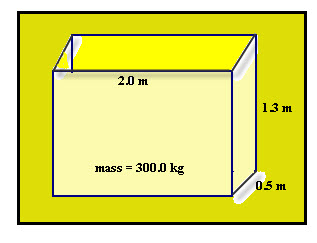 Density is a comparison of mass and volume. In other words, density relates two types of units, mass and volume.
Density is a comparison of mass and volume. In other words, density relates two types of units, mass and volume.
For example, water has a density of 1 g/ml. This means that 1 milliliter of water has a mass of 1 gram. This is a density that you need to memorize, but, given enough information, the density of other materials can be calculated. For example, in the following problem the density of a box is asked for. Note that I am showing you how to think through such a problem.
Problem
The density of a box, which is 2.0 m long, 0.5 m wide, and 1.3 m high and has a mass of 300.0 kg is ? kg/m3
Facts:
Equations You should know:
d = m/v (density = mass/volume ; density equal mass divided by volume)
v = l x w x h (volume equals length times width time height)
Information from the problem:
v = 2.o m x 0.5 m x 1.3 m
= 1.3 m3 (Note: m x m x m = cubed meters)
mass box = 300.0 kg
Problem Map (This is a basic plan starting with facts from the problem and ending with units that are to be in the answer.)
START——————————————————> Finish
mass and volume are given ——————————–> density = ? kg/m3
Clue: If you are trying to calculate the density of something, USE THE DENSITY EQUATION
<!– @page { margin: 0.79in } P { margin-bottom: 0.08in } A:link { so-language: zxx } –>
d = m/v = 300.0 kg/1.3 m3
= 230.769 kg/1m3
Significant Figures: Your answer can only be accurate to the least number of significant figures in the problem.
2.0 = 2 sig figs
1.3 = 2 sig figs
300.0 = 4 sig figs
Answer: 230 kg/m3 (two sig figs)